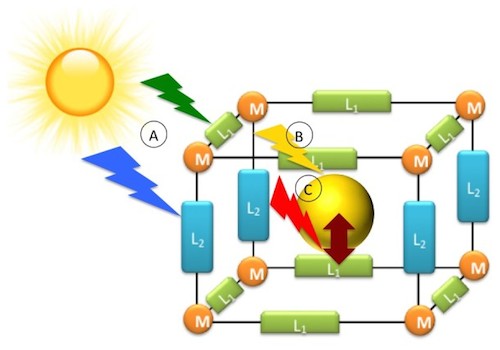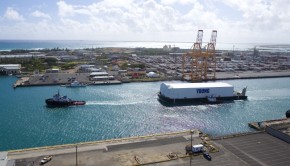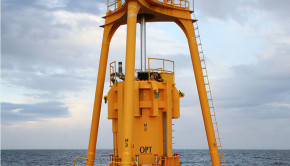New “Tinker Toy” Test Could Send Solar Energy Costs Into Free-Fall
November 6th, 2014 by Tina Casey
Solar energy costs are already dropping faster than you can say “solar energy costs are dropping,” and along comes a new development that could accelerate the trend even more. The project, out of Sandia National Laboratories in partnership with the University of Colorado-Boulder, aims at working around the efficiency limitations of dye-sensitized solar cells.
The idea is to combine the dye-based technology with another material that researchers compare to that icon of childhood play, the Tinker Toy. Dye-sensitized solar cells lend themselves to a low cost manufacturing process, so breaking through the efficiency wall lets you have your solar cake and eat it, too.
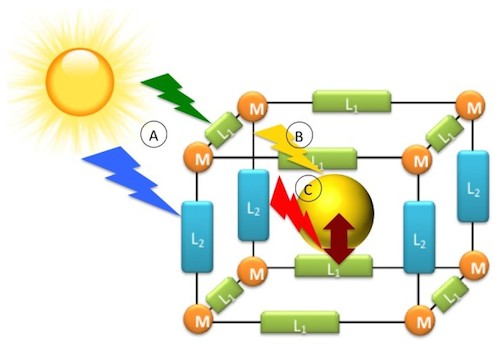
Use of MOF in a dye sensitized solar cell (courtesy of Sandia National Laboratories).
A Promising Technology For Reducing Solar Energy Costs…
As described by Sandia’s press materials on the new solar energy cost breakthrough, dye-sensitized solar cells have been around since the 1980’s. As the name indicates, the technology involves specialized dyes that enable the solar cell to absorb light more effectively.
This development made a big difference in solar cell R&D, because it enabled researchers to break down the process of generating a current into separate components. Each “module” can be tweaked to maximize efficiency without throwing the whole system out of kilter.
…But There’s Trouble In Paradise
Where the technology runs into trouble is the tendency of the dyes to “clump” onto the semiconductor material, which is where the action takes place in terms of converting solar energy to a usable current.
Typically, the semiconductor in dye sensitized solar cells is titanium dioxide, a commonly used substance (for example, as the key ingredient in white paint). When the dye eventually aggregates on the titanium dioxide surface, it brings down the efficiency of the solar cell.
Sandia To The Rescue!
To get around that problem, Sandia plans to deploy its expertise in the field of metal-organic framework (MOF) materials.
We’ve previously discussed MOF in the context of Pacific Northwest National Laboratory’s research into next-generation batteries. Described by that team as a “unique, powdery nanomaterial,” MOF refers to a crystalline compound of metal clusters linked by organic molecules, which self-assemble into a porous structure.
The Sandia description is similar, with the added observation that because of the highly ordered nature of MOF, researchers find it easy to “envision and assemble” new structures. It’s not quite as easy as putting together Tinker Toys, but that’s the general idea according to Sandia.
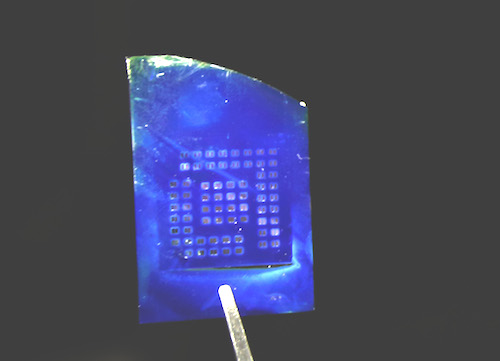
Silicon chip coated with MOF film over an oxide layer, with an array of platinum electrodes (photo by Dino Vournas courtesy of Sandia National Laboratories, cropped and enhanced for clarity).
The new project will involve layering MOF over the titanium dioxide, to lock in the placement of the dye. The secret sauce, though, will be an extra layer of dye enabled by MOF, as described by Sandia:
…the unique porosity of MOFs will allow researchers to add a second dye, placed into the pores of the MOF, that will cover additional parts of the solar spectrum that weren’t covered with the initial dye.
Here’s a couple of snippets from Sandia materials scientist Erik Spoerke enthusing about the potentials:
Essentially, we believe MOFs can help to more effectively organize the electronic and nano-structure of the molecules in the solar cell. This can go a long way toward improving the efficiency and stability of these assembled devices…
…With the combination of MOFs, dye-sensitized solar cells and atomic layer deposition, we think we can figure out how to control all of the key cell interfaces and material elements in a way that’s never been done before.
Before we get too carried away, let’s note for the record that however low the cost of manufacturing solar cells may go, a good chunk of the installed cost of solar energy still hinges on a variety of non-cell factors including marketing, administration, design, permitting, and labor costs. By the same token, though, by chipping away at solar cell costs while improving efficiency you can gain a significant impact on overall solar energy costs.
Group Hug For Lower Solar Energy Costs
As you may have gathered from the above quote, so far the Sandia team is dealing with hypotheticals. To pick up the pace of the R&D, the Energy Department has just awarded the lab an extra $1.2 million for the project through the SunShot Initiative. So, group hug all you taxpayers!
Sandia of course is part of the Energy Department’s network of taxpayer-supported national laboratories, operated by a wholly owned subsidiary of our friends over at Lockheed Martin Corp.
Lockheed is better known for its aircraft and Defense Department contracts, so if you’re wondering about the company’s connection to solar energy check out some of its recent clean energy ventures such as waste gas-to-ethanol, next-generation wave energy, and a nifty little compact fusion reactor.
Follow me on Twitter and Google+.
Keep up to date with all the hottest cleantech news by subscribing to our (free) cleantech newsletter, or keep an eye on sector-specific news by getting our (also free) solar energy newsletter, electric vehicle newsletter, or wind energy newsletter.
-
JamesWimberley
-
Michael G
-
-
Michael G
-
JamesWimberley
-
Bob_Wallace
-
-
-
Offgridman
-
Offgridman
-
Bob_Wallace
-
Offgridman
-
Bob_Wallace
-
Offgridman
-
Bob_Wallace
-
-
-
-


